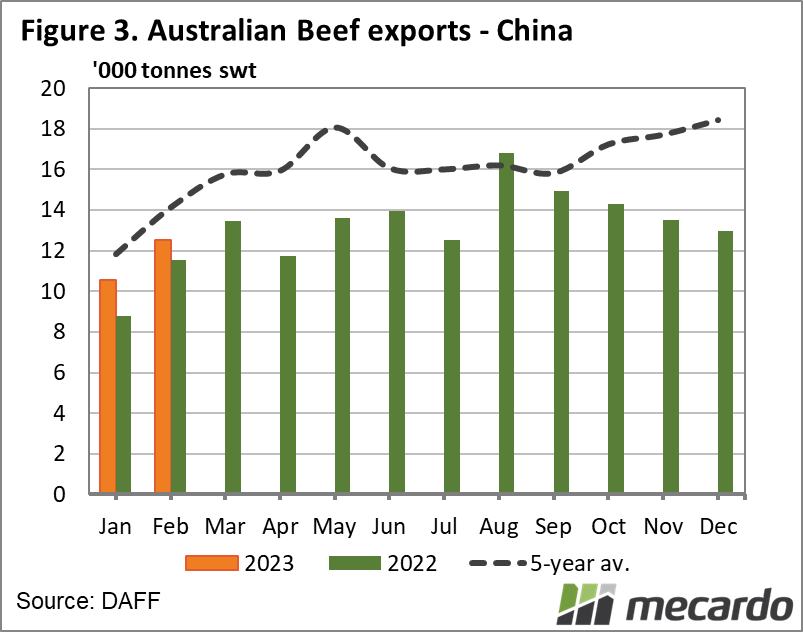Australian beef exports have been on the rise for the first two months of the year, as extra cattle slaughter domestically and keen global demand align to boost trade. Our five biggest beef markets have all taken more product for the year-to-date compared to 2022, with slaughter in the US on the decrease and Asian appetites for beef still growing. Meat and Livestock Australia’s latest cattle projections, released last month, have forecast Australian beef exports to rise 16% year-on-year in 2023, and 2025 volumes 24% above last year’s total.
Total Australian beef exports closed 2022 down 4% on the previous year at 854,592 tonnes, the lowest volumes since 2003. The US accounted for a good portion of this reduction, with its share of the Australian market dropping to just above 15%, the lowest it has been in at least 15 years. In 2022, the US imported 38% less beef from Australia than its five-year average, as wide-spread drought encouraged significant turn-off of their own beef herd. South Korea was the other big market which took less beef, albeit their volume was only down 3% year-on-year, and they maintained a historically strong market share of close to 19%.
The tide has turned in the US as their slaughter figures fall and domestic lean beef price rises, leaving buyers once again looking to Australia, especially as our sector does the opposite. Exports of beef to the US have lifted 30% for the year-to-February, and now sit well above both 2022 and 2021 volumes. The Steiner Consulting Group’s latest US imported beef market report expects Australian beef exports to the US to continue to lift in March and April as more cattle go to slaughter domestically here, with increased demand from Asia taking up supply flagged as the only potential speedbump.
Looking to Asian markets, firstly China, the latest Mad Cow Disease (BSE) scare in Brazil seems to have been just a flash in the pan, with the announcement coming that the recent case was Atypical. However, it could still take a bit of time for China to lift their temporary export ban on Brazil. Australian exports to China jumped 14% for January/February compared to last year, and actually closed 2022 6% higher year-on-year. South Korea and Japan are up 18% and 8% respectively for the year so far, and Indonesia has jumped a whopping 140% compared to 2022, taking 9% of the market in February, which was its highest monthly percentage yet.
What does it mean?
Steiner has cautioned that global economic downturn concern could spread to Asia and start to impact higher cost protein demand, but all other factors in the Australia beef export market remain positive. The US will continue to need more lean beef as their slaughter tightens up, and we have plenty to process now. China’s demand has also been on the rise since they have scrapped the covid-19 restrictions, and if the bans on specific Australian abattoirs are lifted, it could mean even more beef headed that way. And the growing demand from the currently smaller Asian markets will also be interesting to watch.
Have any questions or comments?
Key Points
- Australian beef exports on the rise, up 18% on 2022 levels last month, as supply improves
- Exports to the US improved 30% year-on-year for February as their domestic supply tightens
- China has increased their intake of Australian beef by 14% for the year-to-date compared to last year.
Click on figure to expand
Data sources: Mecardo, MLA, Steiner Consulting















